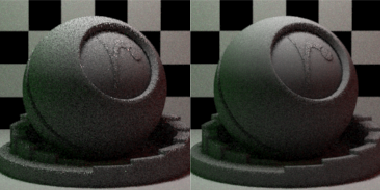
 |
 |
Importance Resampling for BSSRDF Ryusuke Villemin, Christophe Hery, Per Christensen November 2016 We present a method to improve BSSRDF rendering, which reduces variance due to sampling of the scattering exit point. By using importance resampling, we are able to sample any arbitrary diffusion model, taking into account the geometry of the object at the same time. The new method is trivial to implement ... more Paper (PDF) Available as Pixar Technical Memo #16-05 |
 |
Building an Orthonormal Basis, Revisited Tom Duff, James Burgess, Per Christensen, Christophe Hery, Andrew Kensler, Max Liani, Ryusuke Villemin March 2017 Frisvad [2012b] describes a widely-used computational method for augmenting a given single unit vector with two other vectors to produce an orthonormal frame in three dimensions, a useful operation for any physically based renderer. The implementation has a precision problem: as the z component of the input vector approaches -1, floating point cancellation causes ... more Paper (PDF) |
 |
Progressive Sampling Strategies for Disk Light Sources Per Christensen June 2018 This technical memo compares six different strategies for sampling a disk area light source. We test padding the domain with zero values, rejection sampling, polar mapping, concentric mapping, and two new strategies we call polar4 and concentric4 mapping. We test the six strategies with nine different sample sequences ... more Paper (PDF) Available as Pixar Technical Memo #18-02 |
 |
Progressive Multi-Jittered Sample Sequences Per Christensen, Andrew Kensler, Charlie Kilpatrick July 2018 We introduce three new families of stochastic algorithms to generate progressive 2D sample point sequences. This opens a general framework that researchers and practitioners may find useful when developing future sample sequences. Our best sequences have the same low sampling error as the best known sequence (a particular randomization of ... more Paper (PDF) Additional materials: [pmj_slides.pdf], [pmj_suppl.pdf] Computer Graphics Forum (Proceedings of the Eurographics Symposium on Rendering 2018) |
 |
RenderMan: An Advanced Path Tracing Architecture for Movie Rendering Per Christensen, Julian Fong, Jonathan Shade, Wayne Wooten, Brenden Schubert, Andrew Kensler, Stephen Friedman, Charlie Kilpatrick, Cliff Ramshaw, Marc Bannister, Brenton Rayner, Jonathan Brouillat, Max Liani July 2018 Pixar's RenderMan renderer is used to render all of Pixar's films, and by many film studios to render visual effects for live-action movies. RenderMan started as a scanline renderer based on the Reyes algorithm, and was extended over the years with ray tracing and several global illumination algorithms. This paper describes the modern version of ... more Paper (PDF) |
 |
Orthogonal Array Sampling for Monte Carlo Rendering Wojciech Jarosz, Afnan Enayet, Andrew Kensler, Charlie Kilpatrick, Per Christensen July 2019 We generalize N-rooks, jittered, and (correlated) multi-jittered sampling to higher dimensions by importing and improving upon a class of techniques called orthogonal arrays from the statistics literature. Renderers typically combine or "pad" a collection of lower-dimensional (e.g. 2D and 1D) stratified patterns to form higher-dimensional samples for integration. ... more Paper (PDF) Additional materials: [images.tar.xz], [supplemental.pdf] |
 |
Stochastic Generation of (t,s) Sample Sequences Andrew Helmer, Per Christensen, and Andrew Kensler Nov 2021 We introduce a novel method to generate sample sequences that are progressively stratified both in high dimensions and in lower-dimensional projections. Our method comes from a new observation that Owen-scrambled quasi-Monte Carlo (QMC) sequences can be generated as stratified samples, merging the QMC construction and random scrambling into a stochastic ... more Paper (PDF) Additional materials: [suppl.pdf] Eurographics Symposium on Rendering 2021 |
 |
RenderMan XPU: A Hybrid CPU+GPU Renderer for Interactive and Final-Frame Rendering Per Christensen, Julian Fong, Charlie Kilpatrick, Francisco Gonzalez, Srinath Ravichandran, Akshay Shah, Ethan Jaszewski, Stephen Friedman, James Burgess, Trina M. Roy, Tom Nettleship, Meghana Seshadri, Susan Salituro June 2025 RenderMan XPU is a rewrite of Pixar's RenderMan renderer, designed to run on both CPUs and GPUs. Like its predecessor, it is a progressive path tracer, suitable for both interactive previews and high-quality final-frame rendering, but it utilizes modern hardware and software techniques to run significantly faster. Most ... more Paper (PDF) Additional materials: [video.mp4] Computer Graphics Forum (Proceedings of High-Performance Graphics) |